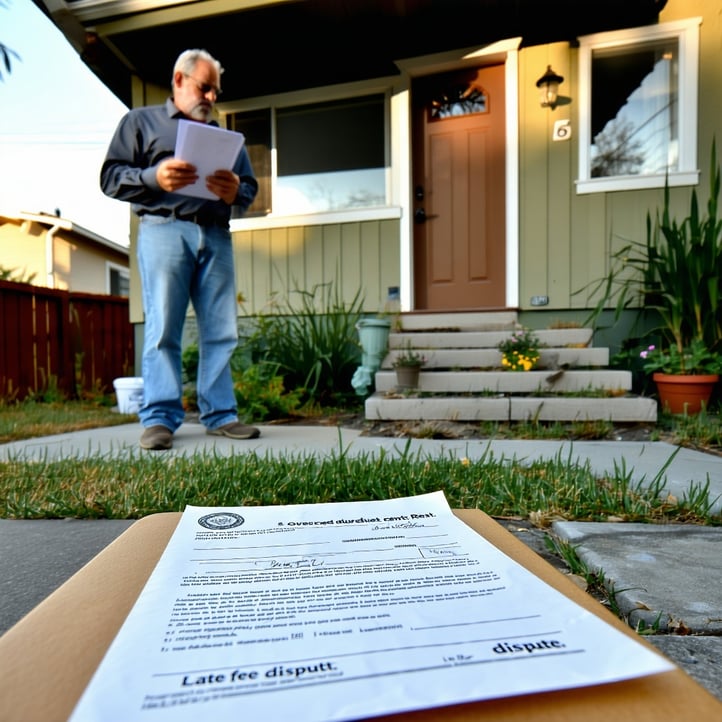If a tenant disappears and stops paying rent, it might seem like a simple situation you assume they’ve moved out, you change the locks, and you move on. But in California, it's not that simple. Landlords must follow a strict legal process to avoid costly legal claims, even when a tenant appears to have abandoned the property. Here’s what every landlord should know to stay compliant and protected.
What Is Abandonment?
Abandonment of real property occurs when a tenant stops paying rent and appears to have vacated the unit with no intention of returning. It often involves a tenant disappearing without formal notice. However, just because a unit looks empty doesn’t mean you can immediately take back possession.
California law provides a procedure for landlords to retake possession when abandonment is suspected without going through formal eviction but only if specific steps are followed. The key is demonstrating a “reasonable belief” that the tenant has truly abandoned the unit.
Step 1: Rent Must Be Unpaid for 14 Days
Before taking any action, confirm that the rent has been unpaid for at least 14 consecutive days. This is a strict legal threshold. If you act before that window, you risk violating the tenant's rights even if the unit looks abandoned.
Step 2: Evaluate the Situation
Next, assess the entire situation. You need to reasonably believe the tenant has vacated without the intent to return. Consider the following indicators:
- Is the unit completely or mostly empty?
- Are utilities shut off?
- Have neighbors reported seeing the tenant move out?
- Did the tenant provide any written notice or communication?
- Is the mailbox full or are packages piling up?
You don’t have to be 100% certain, but your belief must be reasonable based on the circumstances.
Step 3: Serve a Notice of Belief of Abandonment
Once you reasonably believe abandonment has occurred, you must serve a Notice of Belief of Abandonment to the tenant. This is a formal legal notice that tells the tenant you believe they’ve vacated and informs them of your intent to retake possession.
The notice must:
- State the date when you will terminate the lease (minimum 15 days after personal delivery or 18 days after mailing).
- Be delivered personally or mailed to the tenant’s last known address.
- Be sent to any additional known addresses (like a work address), if you believe the tenant might not receive the notice at the last known residence.
What If the Tenant Responds?
If the tenant responds before the notice expires and states that they have not abandoned the unit, you cannot proceed with retaking possession. If they pay any part of the rent due, that also stops the abandonment process.
Step 4: Retake Possession After the Notice Period
If the tenant does not respond by the deadline, you may legally retake possession of the unit without going through the eviction process. However, it’s important to document everything:
- Take photos or video of the unit before touching anything.
- Have a witness present when you enter.
- Post a 24-hour notice before entering unless it’s clearly abandoned.
The 21-day clock for returning the tenant’s security deposit begins when you lawfully retake possession.
Step 5: What About the Tenant’s Stuff?
This is where many landlords make costly mistakes.
Even if the tenant is gone, you cannot simply throw out what they left behind unless it's clearly garbage. California law treats personal property with extreme caution especially if it might have value.
You must take the following steps:
Inventory the Property
Go through what’s left and document it thoroughly. Take photos, list all visible items, and determine whether anything appears valuable.
Send a Notice of Right to Reclaim Abandoned Property
This notice informs the tenant they left items behind and gives them a window of time to reclaim their belongings. The required time is:
- 15 days if served personally
- 18 days if sent by mail
The notice must include:
- A description of the property
- The location where it can be claimed
- Any reasonable storage fees that must be paid
- A deadline for claiming the items
- A statement of what will happen if it’s not reclaimed
There are two possible outcomes:
- Items are Valued at Less than $700
If you reasonably believe the total value of the abandoned property is less than $700, you may keep, sell, or dispose of it after the notice period ends, with no further legal steps.
- Items are Worth $700 or More
If the items appear to be worth $700 or more, you must sell them at a public auction. You’re required to:
- Publish notice of the auction in a local newspaper
- Deduct storage, advertising, and auction costs
- Remit any remaining proceeds to the county (the tenant can claim it later)
Important Limitations
- You cannot demand payment of rent in exchange for returning the property.
- You must return the items to the tenant (or a person you reasonably believe is the owner) if they request it and pay reasonable storage fees.
- If the tenant reclaims the property within two days of vacating, you may not charge any storage fees.
Real Example: The Golf Clubs Incident
At Raintree Property Management, we once had a tenant vacate unexpectedly and leave behind what appeared to be trash in the garage. Our team cleared it out. Days later, the tenant called, furious that his golf clubs hidden in a bag under a tarp had been thrown away.
It was a costly oversight. The clubs were worth more than $1,000, and the tenant could have taken legal action. Thankfully, we resolved it before it escalated. The lesson? When in doubt, document and store everything that’s not clearly trash.
Legal Risks for Landlords Who Skip the Process
Failing to follow California’s abandonment process can expose landlords to:
- Civil penalties of up to $250 per violation if done in bad faith
- Actual damages, up to the value of the property
- Attorney’s fees and court costs if the tenant sues
- Liability for illegal lockout, with fines up to $100/day
In addition, landlords who mishandle the tenant’s property may be ordered to pay compensation, even if the unit was legally retaken.
Best Practices for Landlords
- Always wait the 14-day rent period before starting.
- Document everything: take photos, have witnesses, and save communications.
- Use legal forms such as CAA’s Notice of Belief of Abandonment and Notice of Right to Reclaim Property.
- Be cautious with personal items: if you’re unsure, store and notify.
- Don’t combine lockouts with retaliation or rent collection.
- Consult legal counsel if the situation is unclear or high-value items are left behind.
How Raintree Property Management Handles Abandonment
At Raintree Property Management, we take abandonment seriously and follow the law to the letter. We ensure that:
- The proper notices are served on time.
- Items are inventoried and stored appropriately.
- Owners are kept informed every step of the way.
Our goal is to protect your property and your legal standing while minimizing delays in getting your unit re-rented.
Final Takeaway
Abandonment is not a shortcut to eviction. It’s a legally defined process that must be handled with care. By following the law and documenting each step, you protect yourself from liability and ensure a smooth turnover of the property.
If you suspect a tenant has abandoned your property and aren’t sure how to proceed, reach out to our team at Raintree Property Management. We’ll guide you through every stepby the book.




